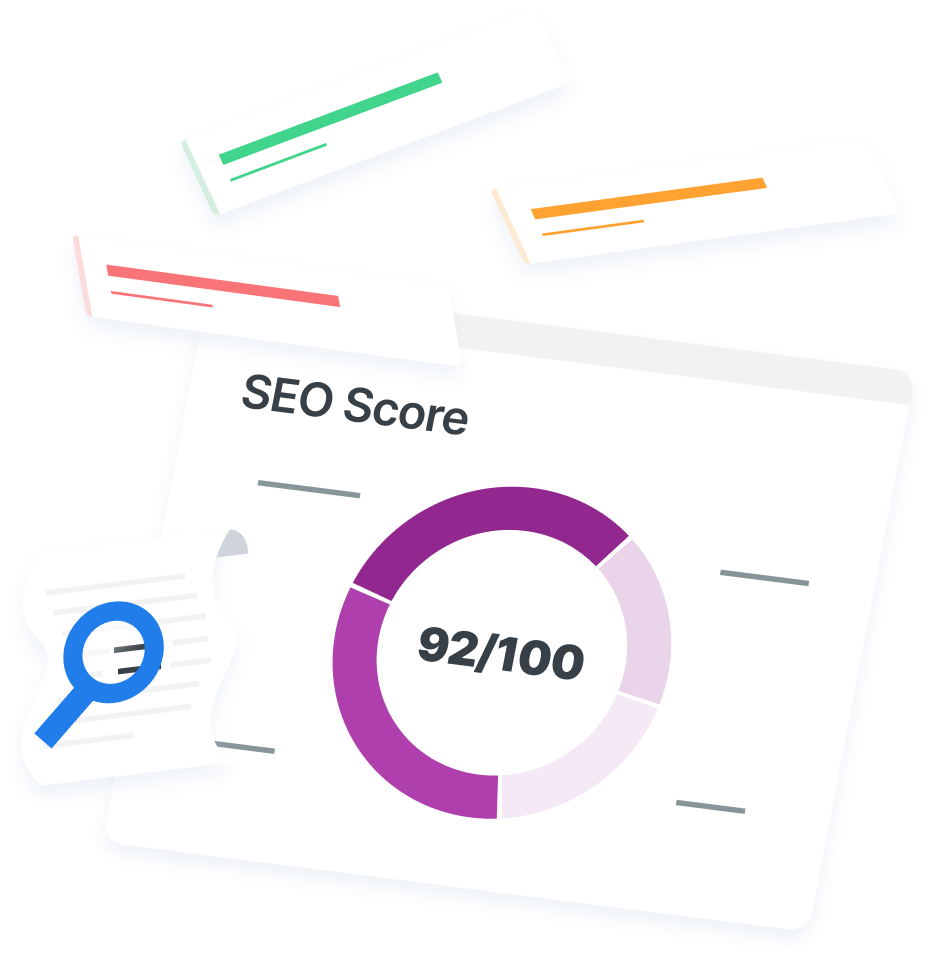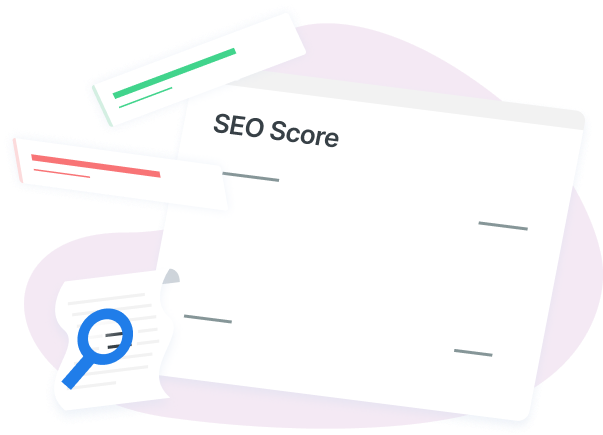-
 Published: Aug 5, 2022
Published: Aug 5, 2022
-
 8 min. read
8 min. read
-
 Kayla Johansen
Kayla Johansen Content Writer
Content Writer
- Kayla is a content specialist with a B.S. in marketing. She is certified in Google Analytics and Google Ads Search and Display. When not writing, she enjoys reading, playing with her dog, and baking.
Your website forms the heart of your online presence, and with over 70% of consumers researching companies online before purchasing or visiting, you need an excellent one.
However, for people to find your website, you need a robust digital marketing strategy — and a way to land high in the search results for searches related to your business.
That’s where search engine optimization (SEO) plays an integral role. SEO is the process of optimizing your site to appear higher on search results pages. The right SEO investment boosts your position in the results, directly impacting how many people click through to your site.
For example, 68% of clicks go to the first five results in Google. If you want searchers to see and visit your website, you’ll want to invest in SEO.
Wondering where to begin with your SEO investment? You’ve come to the right place! In this post, we’ll explore:
Keep reading for your one-stop guide to investing in SEO! And if you’d like to learn more about how to budget for SEO, check out our free SEO pricing guide!
Does your company need to invest in SEO?
You might know how vital your website is to help users find you, and you might even understand the value of a prime spot in search engine results. But without a strategic plan to increase your search engine rankings, you stand a slim chance of appearing as high as you’d like.
However, SEO will help you change that.
SEO is an invaluable marketing strategy for every business, carrying benefits like:
- Appearing where users look for information
- Satisfying your audience with helpful, relevant answers to search queries
- Driving more customers to your website
- Generating long-term results
- Working hand-in-hand with other digital marketing strategies such as web design and content marketing
If you don’t already have an SEO strategy in place, consider adding one to your marketing budget. Any business that wants to reach customers online will benefit from investing in this foundational strategy.
However, as you plan your budget, remember SEO is ongoing and involves many areas of expertise. To see meaningful results from your investment, you’ll need the right team, or you can partner with an SEO company. You’ll also need to be willing to wait a few months to see your results.
Though the initial wait might be long, once you land high in the search results, your initial investment will continue driving traffic and results for years to come.
How to invest in SEO
What if you’re considering investing in SEO but don’t know where to begin? Any company that wants to add SEO to their marketing strategy successfully should follow these steps:
1. Establish and analyze your existing marketing goals
SEO should play a strategic role in your larger digital marketing strategy to drive the most significant results. Before you establish your SEO plan or determine the best investment approach, consider your overall marketing goals.
Are you looking to increase website traffic? Build brand awareness? Drive more sales or generate more leads?
How aggressive of an SEO plan do you need? Will you invest in traditional or local SEO?
These answers will inform your SEO strategy and set the initial foundation to gauge how much SEO will cost.
2. Complete a competitive analysis
Another component that impacts your SEO investment is your competitive landscape. Consider your top competitors and how they perform in the search results.
To accurately determine this information, consider using an SEO tool or competitive analysis tool. You’ll find many free and paid options to suit your needs.
In this step, look at the volume of searches and keywords your competitors rank for. Understanding the search landscape for your industry will help you evaluate your return on investment (ROI) potential.
You’ll also see whether your audience searches for more informational or transactional keywords or an even mix of the two. Both types of searches are helpful to your marketing strategy, but understanding this mix upfront will guide the direction of your SEO investment.
For instance, top-of-funnel searches might focus on driving people to your website. To generate bottom-line results, you’ll need to align your SEO strategy with conversion rate optimization and tactics that keep your visitors on your site to nurture them down the sales funnel.
3. Evaluate your current SEO performance
Once you understand the existing SEO landscape you’ll be diving into, evaluate your site’s performance. Use an SEO tool like Google Search Console or Ahrefs to determine how well you’re ranking in the search results.
Even if you’re ranking highly, you’ll still likely find areas for improvement. Knowing how to improve, though, is challenging due to the many factors involved in SEO. To see actionable areas where your site can improve, plug it into our free SEO checker.
4. Determine your SEO plan
Once you know your site’s SEO strengths and improvement areas, consider which changes will make the greatest impact. While the most strategic improvements vary for each business, some of the most foundational SEO investments include:
- Page speed optimization
- Link-building
- Improving your site architecture
- Optimizing existing content for SEO
- Creating new SEO content
- And more
Some sites might need a comprehensive SEO strategy that includes on-page, off-page, and technical SEO improvements. Others might choose to focus on one or two areas.
Keep your findings in mind as you move into the next step.
5. Evaluate your SEO resources
Now that you know which areas of SEO you need to prioritize, consider your internal resources. To launch a thorough SEO strategy, you’ll need experts in areas like:
- Website design and development
- Content strategy
- Copywriting and content creation
- Outreach
- Data analysis
If you don’t have the in-house knowledge needed to deploy your SEO strategy, you’ll need to decide whether to invest in hiring in-house experts or partnering with an SEO agency.
Both carry benefits, but if you don’t have the time or resources to recruit, train, and manage an SEO team, working with an SEO company takes the burden off your shoulders.
Not sure if you can spare the budget for either of these approaches? Learn DIY SEO! You’ll still need to invest time, and it might take a while to understand every tactic, but the beauty of SEO is that anyone can learn it if necessary.
6. Establish realistic expectations
Before you invest in SEO, ensure you’ve set realistic expectations. SEO carries a substantial ROI, but you’ll need to optimize your site continually and wait to see results.
Whether you outsource your SEO investments or learn the tactics in-house, remember this strategy isn’t one you can spend a couple of months doing, then move on to something else.
The long-term nature means you’ll need to continually work with your SEO company or dedicate a team member — or several — to your site’s optimization.
Before investing in SEO, ensure you’re in it for the long haul.
7. Measure your performance
Another critical aspect of setting realistic expectations is knowing how to attribute your results to SEO. If you invest in this strategy, you need a way to measure your results accurately.
Depending on your SEO goals, noteworthy key performance indicators (KPIs) to track include:
- Search rankings
- Search visibility
- Organic click-through-rate (CTR)
- Bounce rate
- Organic traffic
- Conversion rate
Using analytics tools like Google Analytics to track these metrics will help you evaluate your SEO performance and attribute it to bottom-line results.
ROI of an SEO investment
Now that we’re talking about tracking the ROI of your SEO investments, what sort of SEO ROI can you expect?
Like most aspects of SEO, it depends. Your ROI might vary from another business’s based on factors like:
- Your pre-existing SEO performance
- The amount you chose to invest
- The competitiveness of your field in search
- The aggressiveness of your plan
- And more
However, when invested in strategically, SEO will generate substantial results for your business. To demonstrate the potential, let’s say you run an ecommerce website with an average order value (AOV) of $100.
Before investing in SEO, you see 15,000 monthly organic sessions on average, with a 5% conversion rate.
Your SEO investments help you land higher in the search results, so your monthly organic sessions increase 50% to 22,500.
Wondering if a 50% increase is realistic? Check out our case studies! Our SEO services have driven well over a 50% increase for many clients — up to a 3872% increase in organic sessions!
With 7500 more monthly sessions and the same 5% conversion rate, you’ll generate 375 more conversions every month. At an AOV of $100, that’s $37,500 more monthly revenue.
When you consider SEO pricing, which can cost an average of $1500 to $5000 per month, you can see how high the ROI can go, making SEO well worth it.
And this scenario doesn’t consider how SEO improvements contribute to conversion rate optimization, too!
260%
increase in organic revenue
198%
increase in organic transactions
150%
increase in organic traffic
3872%
increase in sessions from SEO
Invest in SEO from the experts at WebFX
Ready to invest in a digital marketing strategy with an incredible ROI?
Trust the SEO agency with 371 reviews averaging 4.9 stars on Clutch to drive the results you need from SEO. We have over 28 years of experience in 200+ industries.
Our SEO experts will craft a custom strategy that generates the results you need to grow your business. Ready to make your SEO investment and improve your business’s online presence? Call us at 888-601-5359 or request a free proposal online today!
-
 Kayla is a content specialist with a B.S. in marketing. She is certified in Google Analytics and Google Ads Search and Display. When not writing, she enjoys reading, playing with her dog, and baking.
Kayla is a content specialist with a B.S. in marketing. She is certified in Google Analytics and Google Ads Search and Display. When not writing, she enjoys reading, playing with her dog, and baking. -

WebFX is a full-service marketing agency with 1,100+ client reviews and a 4.9-star rating on Clutch! Find out how our expert team and revenue-accelerating tech can drive results for you! Learn more
Try our free SEO Checker
Boost your site’s search performance with our free SEO Checker. Analyze your website for optimization tips on titles, headers, content, speed, and more. Get a free report now to enhance rankings on Google, Bing, Yahoo, and beyond!

Table of Contents
- Does Your Company Need to Invest in SEO?
- How to Invest in SEO
- 1. Establish and Analyze Your Existing Marketing Goals
- 2. Complete a Competitive Analysis
- 3. Evaluate Your Current SEO Performance
- 4. Determine Your SEO Plan
- 5. Evaluate Your SEO Resources
- 6. Establish Realistic Expectations
- 7. Measure Your Performance
- ROI of an SEO Investment
- Invest in SEO from the Experts at WebFX


How Is Your Website’s SEO?
Use our free tool to get your score calculated in under 60 seconds.
Try our free SEO Checker
Boost your site’s search performance with our free SEO Checker. Analyze your website for optimization tips on titles, headers, content, speed, and more. Get a free report now to enhance rankings on Google, Bing, Yahoo, and beyond!







